PORSCHE CAYNNE 2013 2.G Information Manual
Manufacturer: PORSCHE, Model Year: 2013, Model line: CAYENNE, Model: PORSCHE CAYENNE 2013 2.GPages: 79, PDF Size: 14.97 MB
Page 21 of 79

Drive systems and chassis | Engine technology · 42
41 · Drive systems and chassis | Engine technology
Compression with precision.
Essential for getting right to the point.
Direct fuel injection (DFI).
DFI injects fuel directly into the combus -
tion chamber at up to 120 bar with milli -
second precision using electromagnetic
injectors. The injector position and spray
geometry have been carefully designed
to improve output, torque, fuel economy
and emissions. The swirling of the fuel as
it enters each chamber increases the
mixing of air and fuel, thereby enhancing
combustion. By forming the air/fuel mix -
ture directly in the combustion chamber,
DFI contributes to engine cooling. As a
result, it was possible to increase the
compression ratio and therefore power
and efficiency.
Direct fuel injection on the diesel
engine (common-rail injection system).
On the Cayenne Diesel, direct fuel injec -
tion comes courtesy of a common-rail
injection system. The injection pressure
is now up to 2,000 bar, ensuring optimum
distribution of the air/fuel mixture – for
greater performance. The piezoelectric
injectors provide flexible injection rate
adjustment, using exactly metered
quantities of fuel, with multiple injections
for each power stroke to deliver smooth
combustion.
Cooling systems.
A high-performance engine can only
maintain its maximum capability over
a long service life if all components are
operating consistently within a specific
temperature range. The engines in the
Cayenne models are therefore designed
for efficient cooling.
In order to reduce the frictional losses
that occur during warm-up, all Cayenne
models feature comprehensive thermal
management. Using intelligent control,
it activates the different cooling circuits
individually and on demand, thereby
ensuring that the optimum operating
temperature for the engine and trans -
mission is reached more quickly. This
minimises friction – and keeps fuel
consumption and CO
2 emissions low.
The V8 engines have an enhanced coolant
management system offering effective
temperature control throughout the engine.
While 20 % of coolant flows longitudinally
through the crankcase, the remaining 80 %
serves the cylinder heads using the proven
cross-flow principle (from hot to cold).
On all Cayenne models, the piston heads
are cooled using oil-spray jets integrated
within the main lubrication system.
The entire cooling system is designed for
prolonged heav y-dut y use, e.g. off-road
driving or heav y towing and carrying
applications.
Lubrication.
The V8 engines use dry-sump lubrication
to ensure a consistent supply of oil in
all load conditions, especially in off-road
terrain. The oil reservoir is located inside
the engine. This saves on space and
reduces weight.
Oil is circulated around the V8 engines
using a demand-driven pump. This has
been designed for the toughest driving
scenarios on and off road, including per -
formance driving and extreme gradients.
The V6 engines have a wet-sump lubrica -
tion system. Ensuring a reliable supply of
oil, whatever the driving conditions.
For fuel consumption, CO
2 emissions and efficiency class data, please refer to pages 150/151.
Page 22 of 79
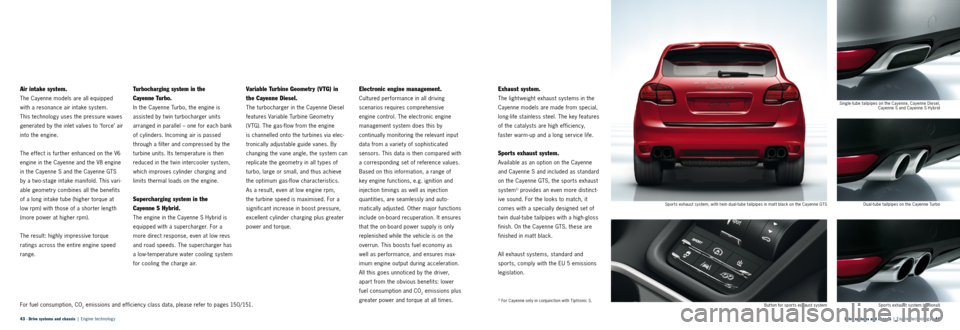
Drive systems and chassis | Engine technology · 44
43 · Drive systems and chassis | Engine technology
Air intake system.
The Cayenne models are all equipped
with a resonance air intake system.
This technology uses the pressure waves
generated by the inlet valves to ‘ force’ air
into the engine.
The effect is further enhanced on the V6
engine in the Cayenne and the V8 engine
in the Cayenne S and the Cayenne GTS
by a t wo -stage intake manifold. This vari -
able geometry combines all the benefits
of a long intake tube (higher torque at
low rpm) with those of a shorter length
(more power at higher rpm).
The result: highly impressive torque
ratings across the entire engine speed
range.
Turbocharging system in the
Cayenne Turbo.
In the Cayenne Turbo, the engine is
assisted by t win turbocharger units
arranged in parallel – one for each bank
of cylinders. Incoming air is passed
through a filter and compressed by the
turbine units. Its temperature is then
reduced in the twin intercooler system,
which improves cylinder charging and
limits thermal loads on the engine.
Supercharging system in the
Cayenne S Hybrid.
The engine in the Cayenne S Hybrid is
equipped with a supercharger. For a
more direct response, even at low revs
and road speeds. The supercharger has
a low-temperature water cooling system
for cooling the charge air.
Variable Turbine Geometry (VTG) in
the Cayenne Diesel.
The turbocharger in the Cayenne Diesel
features Variable Turbine Geometry
(V TG). The gas-flow from the engine
is channelled onto the turbines via elec -
tronically adjustable guide vanes. By
changing the vane angle, the system can
replicate the geometry in all t ypes of
turbo, large or small, and thus achieve
the optimum gas-flow characteristics.
As a result, even at low engine rpm,
the turbine speed is maximised. For a
significant increase in boost pressure,
excellent cylinder charging plus greater
power and torque.
Electronic engine management.
Cultured performance in all driving
scenarios requires comprehensive
engine control. The electronic engine
management system does this by
continually monitoring the relevant input
data from a variet y of sophisticated
sensors. This data is then compared with
a corresponding set of reference values.
Based on this information, a range of
key engine functions, e.g. ignition and
injection timings as well as injection
quantities, are seamlessly and auto -
matically adjusted. Other major functions
include on-board recuperation. It ensures
that the on-board power supply is only
replenished while the vehicle is on the
overrun. This boosts fuel economy as
well as performance, and ensures max -
imum engine output during acceleration.
All this goes unnoticed by the driver,
apart from the obvious benefits: lower
fuel consumption and CO
2 emissions plus
greater power and torque at all times.
Exhaust system.
The light weight exhaust systems in the
Cayenne models are made from special,
long-life stainless steel. The key features
of the catalysts are high efficiency,
faster warm-up and a long service life.
Sports exhaust system.
Available as an option on the Cayenne
and Cayenne S and included as standard
on the Cayenne GTS, the sports exhaust
system
1) provides an even more distinct -
ive sound. For the looks to match, it
comes with a specially designed set of
t win dual-tube tailpipes with a high-gloss
finish. On the Cayenne GTS, these are
finished in mat t black.
All exhaust systems, standard and
sports, comply with the EU 5 emissions
legislation.
1) For Cayenne only in conjunction with Tiptronic S. Single-tube tailpipes on the Cayenne, Cayenne Diesel,
Cayenne S and Cayenne S Hybrid
Dual-tube tailpipes on the Cayenne Turbo
Sports exhaust system (optional)
But ton for spor ts exhaust system
Spor ts exhaust system, with t win dual -tube tailpipes in mat t black on the Cayenne GTS For fuel consumption, CO2 emissions and efficiency class data, please refer to pages 150/151.
Page 23 of 79
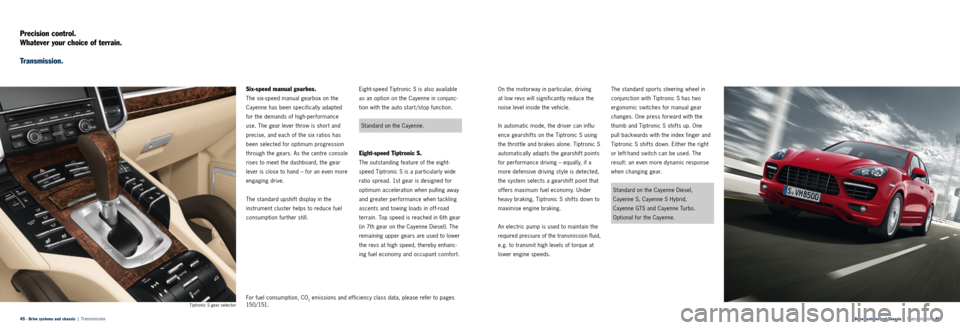
Drive systems and chassis | Transmission · 46
45 · Drive systems and chassis | Transmission
Precision control.
Whatever your choice of terrain.
Transmission.
Six-speed manual gearbox.
The six-speed manual gearbox on the
Cayenne has been specifically adapted
for the demands of high-performance
use. The gear lever throw is short and
precise, and each of the six ratios has
been selected for optimum progression
through the gears. As the centre console
rises to meet the dashboard, the gear
lever is close to hand – for an even more
engaging drive.
The standard upshift display in the
instrument cluster helps to reduce fuel
consumption further still. Eight-speed Tiptronic S is also available
as an option on the Cayenne in conjunc
-
tion with the auto start/stop function.
Standard on the Cayenne.
Eight-speed Tiptronic S.
The outstanding feature of the eight-
speed Tiptronic S is a particularly wide
ratio spread. 1st gear is designed for
optimum acceleration when pulling away
and greater performance when tackling
ascents and towing loads in off-road
terrain. Top speed is reached in 6th gear
(in 7th gear on the Cayenne Diesel). The
remaining upper gears are used to lower
the revs at high speed, thereby enhanc -
ing fuel economy and occupant comfort. On the motorway in particular, driving
at low revs will significantly reduce the
noise level inside the vehicle.
In automatic mode, the driver can influ -
ence gearshifts on the Tiptronic S using
the throt tle and brakes alone. Tiptronic S
automatically adapts the gearshift points
for performance driving – equally, if a
more defensive driving st yle is detected,
the system selects a gearshift point that
offers maximum fuel economy. Under
heav y braking, Tiptronic S shifts down to
maximise engine braking.
An electric pump is used to maintain the
required pressure of the transmission fluid,
e.g. to transmit high levels of torque
at
lower engine speeds. The standard sports steering wheel in
conjunction with Tiptronic S has two
ergonomic switches for manual gear
changes. One press forward with the
thumb and Tiptronic S shifts up. One
pull backwards with the index finger and
Tiptronic S shifts down. Either the right
or left-hand switch can be used. The
result: an even more dynamic response
when changing gear.
Standard on the Cayenne Diesel,
Cayenne S, Cayenne S Hybrid,
Cayenne GTS and Cayenne Turbo.
Optional for the Cayenne.
Tiptronic S gear selector
For fuel consumption, CO2 emissions and efficiency class data, please refer to pages
15 0/ 151.
Page 24 of 79
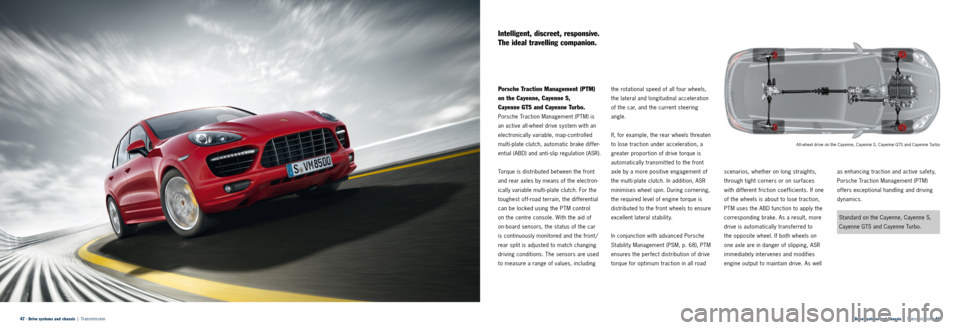
All -wheel drive on the Cayenne, Cayenne S, Cayenne GTS and Cayenne Turbo
Drive systems and chassis | Transmission · 48
47 · Drive systems and chassis | Transmission
Intelligent, discreet, responsive.
The ideal travelling companion.
Porsche Traction Management (PTM)
on the Cayenne, Cayenne S,
Cayenne GTS and Cayenne Turbo.
Porsche Traction Management (PTM) is
an active all-wheel drive system with an
electronically variable, map-controlled
multi-plate clutch, automatic brake differ -
ential (ABD) and anti-slip regulation (ASR).
Torque is distributed bet ween the front
and rear axles by means of the electron -
ically variable multi-plate clutch. For the
toughest off-road terrain, the differential
can be locked using the PTM control
on the centre console. With the aid of
on-board sensors, the status of the car
is continuously monitored and the front/
rear split is adjusted to match changing
driving conditions. The sensors are used
to measure a range of values, including the rotational speed of all four wheels,
the lateral and longitudinal acceleration
of the car, and the current steering
angle.
If, for example, the rear wheels threaten
to lose traction under acceleration, a
greater proportion of drive torque is
automatically transmit ted to the front
axle by a more positive engagement of
the multi-plate clutch. In addition, ASR
minimises wheel spin. During cornering,
the required level of engine torque is
distributed to the front wheels to ensure
excellent lateral stability.
In conjunction with advanced Porsche
Stabilit y Management (PSM, p. 68), PTM
ensures the perfect distribution of drive
torque for optimum traction in all road
scenarios, whether on long straights,
through tight corners or on surfaces
with different friction coefficients. If one
of the wheels is about to lose traction,
PTM uses the ABD function to apply the
corresponding brake. As a result, more
drive is automatically transferred to
the opposite wheel. If both wheels on
one axle are in danger of slipping, ASR
immediately intervenes and modifies
engine output to maintain drive. As well as enhancing traction and active safet y,
Porsche Traction Management (PTM)
offers exceptional handling and driving
dynamics.Standard on the Cayenne, Cayenne S,
Cayenne GTS and Cayenne Turbo.
Page 25 of 79

Drive systems and chassis | Transmission · 50
49 · Drive systems and chassis | Transmission
Porsche Traction Management
(PTM) on the Cayenne Diesel and
Cayenne S Hybrid.
The Cayenne Diesel and Cayenne S
Hybrid feature a permanent all-wheel
drive system with self-locking centre
differential. This provides a standard
torque split of 60 % to the rear and
40 % to the front. If one of the wheels
is about to lose grip, the self-locking
centre differential transmits the torque
to the axle offering the highest level of
traction.
The ASR and ABD systems
work in the same way as in the PTM on
the Cayenne, Cayenne S, Cayenne GTS
and Cayenne Turbo.
On the Cayenne Diesel and Cayenne S
Hybrid, PTM also enables variable distribution of engine torque to the rear
wheels, thereby enhancing steering pre
-
cision and driving dynamics. Specifically,
this means that when entering a corner
at high speed, moderate brake pressure
is applied to the inside rear wheel.
This supports the steering motion of
the car, thereby improving its cornering
dynamics.
Standard on the Cayenne Diesel and
Cayenne S Hybrid.
Downhill assistance.
A standard feature on all Cayenne models,
Porsche Hill Control (PHC) provides
downhill assistance by maintaining a
constant rate of speed on extreme downhill gradients. It is activated via a
switch on the centre console. The speed
can be set to bet ween 3 and 30 km/ h.
Page 26 of 79

Drive systems and chassis | Off-road capability · 52
51 · Drive systems and chassis | Off-road capability
From urban jungle to the windy wilds.
The Cayenne is perfectly at home on any terrain.
Off-road capability.
Steep ascents leading to snow- covered
mountain lodges, boggy ground or
muddy, loose surfaces – all situations
that the Cayenne handles superbly with
intelligent all-wheel drive. The drive
systems featured on the Cayenne models
deliver exceptional torque. For plent y of
power on tap. On any terrain.
Operating concept.
With the help of Porsche Traction
Management (PTM), the Cayenne can
cope with even the most demanding
off-road scenarios. Simply move the
main off-road control on the centre
console forward or backward to select
one of up to three off-road modes
(depending on the model). Available
on the Cayenne, Cayenne Diesel,
Cayenne S, Cayenne GTS and Cayenne
Turbo, this
function readies the car for
off-road use or reverts the set ting to
normal road driving.
In Off-road Mode 1, for example, the
maps for all relevant systems, e.g. ABS,
are adapted to provide optimum traction.
In addition, High Level I is selected
on vehicles featuring air suspension
with PASM. If that ’s not enough, the air
suspension can be raised further to
High Level II to increase the approach/
departure angle and wading depth.
1)
Push the off-road control forward again
on the Cayenne, Cayenne S, Cayenne GTS
and Cayenne Turbo to activate Off-road
Mode 2 – for even greater traction on difficult terrain, the multi-plate clutch can
be fully locked.
The electronically variable rear diffe
r-
ential on the optional Porsche Torque
Vectoring Plus (PT V Plus, p. 56) is inte -
grated within the all-wheel drive system.
This automatically ensures the optimum
distribution of drive torque on particular -
ly uneven surfaces. If one of the rear
wheels begins to slip, the rear differential
varies the amount of torque transmit ted
through each drive shaft, thereby restor -
ing traction. In Off-road Mode 3, the rear
differential can be manually locked using
the main off-road control. Then both
rear wheels receive the same amount of
torque, regardless of surface conditions.
The optional PDCC (p. 55) enables greater wheel articulation in all three
modes, improving traction still further.
For effective prevention of damage to the
underside of the car, all Cayenne models
can be equipped with optional off-road
underbody protection comprising rock
rails with integrated skid plates, a
reinforced engine-bay guard, additional
protection for fuel tank and rear axle,
and a second towing lug.
1) The Cayenne GTS has a steel -spring spor ts suspension with a 24 mm reduction in ride height (20 mm reduction with optional air suspension). This will lead to restricted capabilit y when driving of f road.
Main off-road control
Page 27 of 79
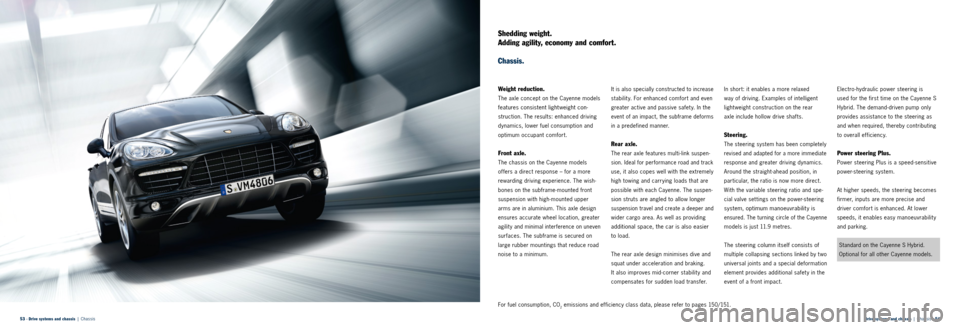
Drive systems and chassis | Chassis · 54
53 · Drive systems and chassis | Chassis
Shedding weight.
Adding agility, economy and comfort.
Chassis.
Weight reduction.
The axle concept on the Cayenne models
features consistent lightweight con -
struc
tion. The results: enhanced driving
dynamics, lower fuel consumption and
optimum occupant comfort.
Front axle.
The chassis on the Cayenne models
offers a direct response – for a more
rewarding driving experience. The wish -
bones on the subframe-mounted front
suspension with high-mounted upper
arms are in aluminium. This axle design
ensures accurate wheel location, greater
agility and minimal interference on uneven
surfaces. The subframe is secured on
large rubber mountings that reduce road
noise to a minimum.
It is also specially constructed to increase
stability. For enhanced comfort and even
greater active and passive safet y. In the
event of an impact, the subframe deforms
in a predefined manner.
Rear axle.
The rear axle features multi-link suspen -
sion. Ideal for performance road and track
use, it also copes well with the extremely
high towing and carrying loads that are
possible with each Cayenne. The suspen -
sion struts are angled to allow longer
suspension travel and create a deeper and
wider cargo area. As well as providing
additional space, the car is also easier
to
load.
The rear axle design minimises dive and
squat under acceleration and braking.
It also improves mid-corner stability and
compensates for sudden load transfer. In short: it enables a more relaxed
way of driving. Examples of intelligent
lightweight construction on the rear
axle include hollow drive shafts.
Steering.
The steering system has been com pletely
revised and adapted for a more immediate
response and greater driving dynamics.
Around the straight-ahead pos ition, in
particular, the ratio is now more direct.
With the variable steering ratio and spe -
cial valve settings on the power-steering
system, optimum manoeuvrability is
ensured. The turning circle of the Cayenne
models is just 11.9 metres.
The steering column itself consists of
multiple collapsing sections linked by two
universal joints and a special deformation
element provides additional safet y in the
event of a front impact. Electro -hydraulic power steering is
used for the first time on the Cayenne S
Hybrid. The demand-driven pump only
provides assistance to the steering as
and when required, thereby contributing
to overall efficiency.
Power steering Plus.
Power steering Plus is a speed-sensitive
power-steering system.
At higher speeds, the steering becomes
firmer, inputs are more precise and
driver comfort is enhanced. At lower
speeds, it enables easy manoeuvrability
and parking.
Standard on the Cayenne S Hybrid.
Optional for all other Cayenne models.
For fuel consumption, CO2 emissions and efficiency class data, please refer to pages 150/151.
Page 28 of 79
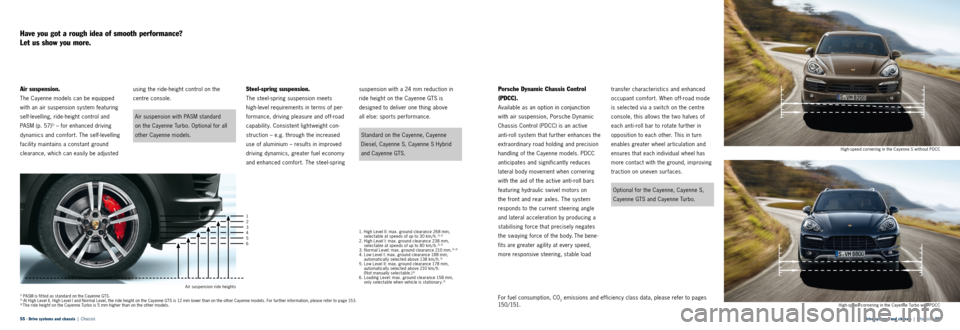
1
2
3
4
5
6
Air suspension ride heightsDrive systems and chassis | Chassis ·
56
55 · Drive systems and chassis | Chassis High-speed cornering in the Cayenne Turbo with PDCCHigh-speed cornering in the Cayenne S without PDCC
1) PASM is fit ted as standard on the Cayenne GTS.2)
At High Level II, High Level I and Normal Level, the ride height on the Cayenne GTS is 12 mm lower than on the other Cayenne models. For fur ther information, please refer to page 153.3) The ride height on the Cayenne Turbo is 5 mm higher than on the other models.For fuel consumption, CO2 emissions and efficiency class data, please refer to pages
15 0/ 151.
Have you got a rough idea of smooth performance?
Let us show you more.
Air suspension.
The Cayenne models can be equipped
with an air suspension system featuring
self-levelling, ride-height control and
PASM (p. 57)
1) – for enhanced driving
dynamics and comfort. The self-levelling
facility maintains a constant ground
clearance, which can easily be adjusted using the ride-height control on the
centre console.
Air suspension with PASM standard
on the Cayenne Turbo. Optional for all
other Cayenne models.
Steel-spring suspension.
The steel-spring suspension meets
high-level requirements in terms of per
-
formance, driving pleasure and off-road
capability. Consistent lightweight con -
struction – e.g. through the increased
use of aluminium – results in improved
driving dynamics, greater fuel economy
and enhanced comfort. The steel-spring suspension with a 24 mm reduction in
ride height on the Cayenne GTS is
designed to
deliver one thing above
all else: sports performance.
Standard on the Cayenne, Cayenne
Diesel, Cayenne S, Cayenne S Hybrid
and Cayenne GTS.
Porsche Dynamic Chassis Control
(PDCC).
Available as an option in conjunction
with air suspension, Porsche Dynamic
Chassis Control (PDCC) is an active
anti-roll system that further enhances the
extraordinary road holding and precision
handling of the Cayenne models. PDCC
anticipates and significantly reduces
lateral body movement when cornering
with the aid of the active anti-roll bars
featuring hydraulic swivel motors on
the front and rear axles. The system
responds to the current steering angle
and lateral acceleration by producing a
stabilising force that precisely negates
the swaying
force of the body. The bene-
fits are greater agilit y at every speed,
more responsive steering, stable load transfer characteris
tics and enhanced
occupant comfort. When off-road mode
is selected via a switch on the centre
console, this allows the t wo halves of
each anti-roll bar to rotate further in
opposition to each other. This in turn
enables greater wheel articu lation and
ensures that each individual wheel has
more contact with the ground, improving
traction on uneven surfaces.
Optional for the Cayenne, Cayenne S,
Cayenne GTS and Cayenne Turbo.
1. High Level II: max. ground clearance 268 mm,
selectable at speeds of up to 30 km/ h. 2), 3)2. High Level I: max. ground clearance 238 mm,
selectable at speeds of up to 80 km/ h. 2), 3)3. Normal Level: max. ground clearance 210 mm. 2), 3)4. Low Level I: max. ground clearance 188 mm,
automatically selected above 138 km/ h. 3)5. Low Level II: max. ground clearance 178 mm,
automatically selected above 210 km/ h.
(Not manually selectable.)
3)6. Loading Level: max. ground clearance 158 mm,
only selectable when vehicle is stationary. 3)
Page 29 of 79
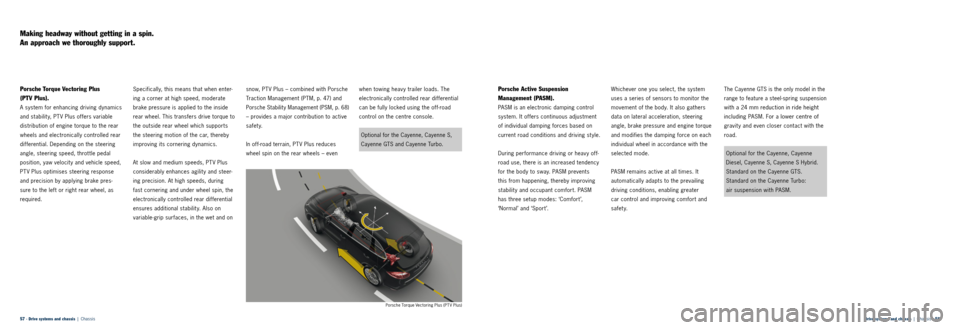
Drive systems and chassis | Chassis · 58
57 · Drive systems and chassis | Chassis
Making headway without getting in a spin.
An approach we thoroughly support.
Porsche Torque Vectoring Plus
(PTV Plus).
A system for enhancing driving dynamics
and stability, PTV Plus offers variable
distribution of engine torque to the rear
wheels and electronically controlled rear
differential. Depending on the steering
angle, steering speed, throttle pedal
position, yaw velocit y and vehicle speed,
PT V Plus optimises steering response
and precision by applying brake pres -
sure to the left or right rear wheel, as
r equired. Specifically, this means that when enter
-
ing a corner at high speed, moderate
brake pressure is applied to the inside
rear wheel. This transfers drive torque to
the outside rear wheel which supports
the steering motion of the car, thereby
improving its cornering dynamics.
At slow and medium speeds, PT V Plus
considerably enhances agility and steer -
ing precision. At high speeds, during
fast cornering and under wheel spin, the
electronically controlled rear differential
ensures additional stabilit y. Also on
variable-grip surfaces, in the wet and on snow, PT V Plus – combined with Porsche
Traction Management (PTM, p. 47) and Porsche Stabilit y Management (PSM, p. 68)
– provides a major contribution to active
safety.
In off-road terrain, PT V Plus reduces
wheel spin on the rear wheels – even when towing heav y trailer loads. The
electronically controlled rear differential
can be fully locked using the off-road
control on the centre console.
Optional for the Cayenne, Cayenne S,
Cayenne GTS and Cayenne Turbo.
Porsche Active Suspension
Management (PASM).
PASM is an electronic damping control
system. It offers continuous adjustment
of individual damping forces based on
current road conditions and driving st yle.
During performance driving or heav y off-
road use, there is an increased tendency
for the body to sway. PASM prevents
this from happening, thereby improving
stability and occupant comfort. PASM
has three setup modes: ‘Comfort ’,
‘Normal’ and ‘Sport’.
Porsche Torque Vectoring Plus (PTV Plus)
Whichever one you select, the system
uses a series of sensors to monitor the
movement of the body. It also gathers
data on lateral acceleration, steering
angle, brake pressure and engine torque
and modifies the damping force on each
individual wheel in accordance with the
selected mode.
PASM remains active at all times. It
automatically adapts to the prevailing
driving conditions, enabling greater
car control and improving comfort and
safety.The Cayenne GTS is the only model in the
range to feature a steel-spring suspension
with a 24 mm reduction in ride height
including PASM. For a lower centre of
gravit y and even closer contact with the
road.
Optional for the Cayenne, Cayenne
Diesel, Cayenne S, Cayenne S Hybrid.
Standard on the Cayenne GTS.
Standard on the Cayenne Turbo:
air suspension with PASM.
Page 30 of 79
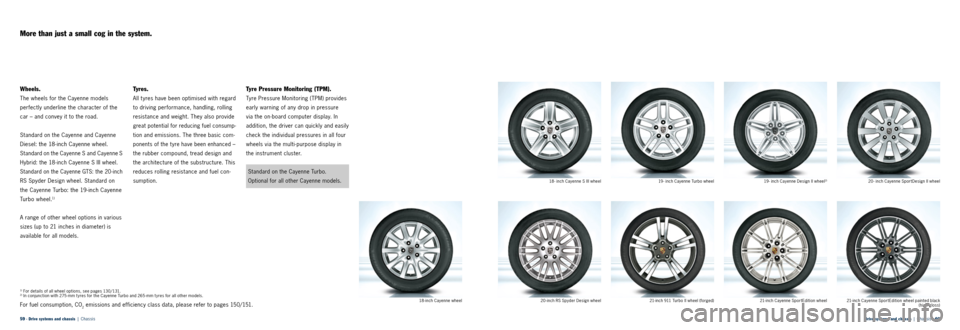
Drive systems and chassis | Chassis · 60
59 · Drive systems and chassis | Chassis
More than just a small cog in the system.
Wheels.
The wheels for the Cayenne models
perfectly underline the character of the
car – and convey it to the road.
Standard on the Cayenne and Cayenne
Diesel: the 18-inch Cayenne wheel.
Standard on the Cayenne S and Cayenne S
Hybrid: the 18-inch Cayenne S III wheel.
Standard on the Cayenne GTS: the 20 -inch
RS Spyder Design wheel. Standard on
the Cayen
ne Turbo: the 19-inch Cayenne
Tu r b o w h e e l .
1)
A range of other wheel options in various
sizes (up to 21 inches in diameter) is
available for all models.
Ty r e s .
All t yres have been optimised with regard
to driving performance, handling, rolling
resistance and weight. They also provide
great potential for reducing fuel consump-
tion and emissions. The three basic com -
ponents of the t yre have been enhanced –
the rubber compound, tread design and
the architecture of the substructure. This
reduces rolling resistance and fuel con -
sumption.
Tyre Pressure Monitoring (TPM).
Tyre Pressure Monitoring (TPM) provides
early warning of any drop in pressure
via the on-board computer display. In
addition, the driver can quickly and easily
check the individual pressures in all four
wheels via the multi-purpose display in
the instrument cluster.
Standard on the Cayenne Turbo.
Optional for all other Cayenne models.
1) For details of all wheel options, see pages 130/131.2) In conjunction with 275 - mm t yres for the Cayenne Turbo and 265 - mm t yres for all other models. 19- inch Cayenne Turbo wheel
20 - inch RS Spyder Design wheel 20 - inch Cayenne Spor tDesign II wheel
19 - inch Cayenne Design II wheel
2)
21-inch Cayenne SportEdition wheel 21-inch Cayenne SportEdition wheel painted black
(high-gloss)
21- inch 911 Turbo II wheel (forged)
18 - inch Cayenne S III wheel
18-inch Cayenne wheelFor fuel consumption, CO2 emissions and efficiency class data, please refer to pages 150/151.